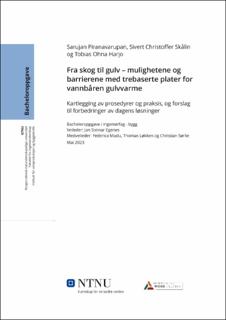| dc.contributor.advisor | Egenes, Jan Steinar | |
| dc.contributor.author | Piranavarupan, Sarujan | |
| dc.contributor.author | Skålin, Sivert Christoffer | |
| dc.contributor.author | Harjo, Tobias Ohna | |
| dc.date.accessioned | 2023-07-14T17:23:18Z | |
| dc.date.available | 2023-07-14T17:23:18Z | |
| dc.date.issued | 2023 | |
| dc.identifier | no.ntnu:inspera:139559409:149521065 | |
| dc.identifier.uri | https://hdl.handle.net/11250/3079118 | |
| dc.description.abstract | I denne bacheloroppgaven har vi utforsket mulighetene for å forbedre dagens bruk av trebaserte plater i kombinasjon med vannbåren gulvvarme for å oppnå en mer bærekraftig og kostnadseffektiv løsning som støtter FNs bærekraftsmål. Vi har kartlagt dagens praksis og identifisert barrierer samt foreslått løsninger for smartere planlegging og utføring av vannbåren varme i trebaserte plater i etasjeskillere.
Vi benyttet kvalitative metoder for datainnsamling, inkludert intervjuer med entreprenører, prosjektledere, produsenter og arkitekter. Vi vurderte validiteten av datainnsamlingen og analysen ved å triangulere funnene med andre datakilder, som observasjoner og dokumenter.
Hovedfunnene i oppgaven inkluderer identifisering av flere barrierer som påvirker valget av trebaserte plater i vannbåren gulvvarme, inkludert kostnader, tid, materialvalg, tekniske utfordringer, ombruk, regelverk og krav. For å gjøre trebaserte plater mer attraktive og kostnadseffektive, er det nødvendig å adressere disse barrierene ved å forbedre tekniske egenskaper, redusere installasjonstid, øke ombruksmulighetene og tilpasse seg eventuelle nye krav i regelverket.
Vi foreslår flere tiltak for å optimalisere planleggings- og produksjonsprosesser ved trebaserte plater, inkludert implementering av prefabrikasjon, Building Information Modeling (BIM), forbedring av veiledning og potensielle insentiver. Kommunikasjon mellom aktører, utvikling av nye produkter og samarbeid mellom industri og forskning er også viktige aspekter som kan bidra til å øke effektiviteten i hele byggeprosessen.
Ved å implementere disse tiltakene og forbedringsmulighetene, kan byggebransjen redusere material- og energiforbruket, øke ressursutnyttelsen og dermed redusere miljøpåvirkningen av byggprosjekter. Dette vil bidra til en mer bærekraftig byggebransje og støtte opp under målet om å redusere klimagassutslipp og ressursbruk i byggsektoren. | |
| dc.description.abstract | In this bachelor thesis, we have explored the possibilities of using wood-based panels in combination with hydronic floor heating to achieve a more sustainable and cost-effective solution that supports the UN's sustainability goals. We have mapped current practices and identified barriers as well as proposed solutions for smarter planning and execution of hydronic heating in wood-based floor panels.
We utilized qualitative methods for data collection, including interviews with contractors, project managers, manufacturers of wood-based panels, and architects. We assessed the validity of the data collection and analysis by triangulating the findings with other data sources, such as observations and documents.
The main findings of the thesis include the identification of several barriers affecting the choice of wood-based panels in hydronic floor heating, including costs, time, material selection, technical challenges, reuse, regulations, and requirements. To make wood-based panels more attractive and cost-effective, it is necessary to address these barriers by improving technical properties, reducing installation time, increasing reusability, and adapting to any new requirements in the regulations.
We propose several measures to optimize planning and production processes for wood-based panels, including the implementation of prefabrication, Building Information Modeling (BIM), improving guidance, and potential incentives. Communication between stakeholders, development of new products, and collaboration between industry and research are also important aspects that can contribute to increasing efficiency throughout the construction process.
By implementing these measures and improvement opportunities, the construction industry can reduce material and energy consumption, increase resource utilization, and thus reduce the environmental impact of construction projects. This will contribute to a more sustainable construction industry and support the goal of reducing greenhouse gas emissions and resource use in the building sector. | |
| dc.language | nob | |
| dc.publisher | NTNU | |
| dc.title | Fra skog til gulv – mulighetene og barrierene med trebaserte plater for vannbåren gulvvarme | |
| dc.type | Bachelor thesis | |
